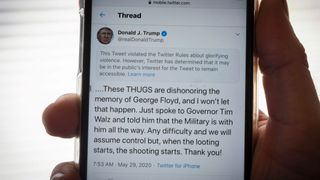The day after Twitter had the temerity to fact check Donald Trump, who has been found to lie and mislead over 18,000 times in the more than 1200 days he has held office, the President was in a Tweet snit: “Republicans feel that Social Media Platforms totally silence conservatives voices. We will strongly regulate, or close them down, before we can ever allow this to happen.”
Twitter’s calling out of Trump’s charges that postal voting is fraudulent – he believes it helps only Democrats – followed his vicious trolling of MSNBC host and former Republican congressman Joe Scarborough, all but alleging he murdered one of his aides. It is a wholly false, despicable, filthy charge, and Trump has utterly resisted recanting the slander, and prefers to keep it alive: “It’s certainly a very suspicious situation. Very sad, very sad and very suspicious.”
What to do with a President who lies continuously from a bully pulpit with over 80 million followers?
Twitter does have standards against abusive bullying, and Trump’s critics want the company to apply it and delete his account – notwithstanding that he is the President of the United States.
Under US law, Twitter and social media platforms lie somewhere between traditional publishers and broadcasters – who have full control over access to their platforms and the content they present on those media – and public utilities, or common carriers, which are pipes along which anyone can travel with no control by the owner of the content of the flow. If it’s electricity or telephony or data bits, the medium carries the message.
Finding the balance in setting and enforcing content standards between digital platforms, with their unlimited capacity and unlimited access by anyone who wants it, is this century’s tech governance issue. Twitter is not legally liable for what appears on its website – the posters of content are. Twitter does have standards against abusive bullying, and Trump’s critics want the company to apply it and delete his account – notwithstanding that he is the President of the United States. But it is precisely because a US President is unique – there is no other – the company has decided it is in the public interest to let the man rip, and let the people decide how they view him and hold him to account.
But on the issue of facts and truth, Twitter has now taken a harder line, and is cautioning Trump posts that are not within factual bounds. That’s what Twitter has started doing with Trump’s tweets – provoking his rage. Twitter went further with a warning Trump violated platform standards and masked a tweet on the violence in Minneapolis and the urgency of the National Guard to restore order. Trump wrote: “When the looting starts, the shooting starts."
Can Trump retaliate further? Speech beyond obscenity, fraud, defamation, incitement to lawless activity is protected by the First Amendment and beyond Trump’s reach. This is especially true for any attempt by the US government to censor Twitter’s platform, or block it – as is done in China.
The executive order Trump has signed seeks to treat internet platforms as publishers. But that would not solve his problem – because his tweets would still be subject to editorial accuracy by the companies.
Trump can punish certain players. Amazon owns The Washington Post, a publisher Trump loathes. Trump has targeted Amazon’s taxes and Postal Service shipping rates. Trump is after Comcast, owner of NBC. His Justice Department brought AT&T, owner of CNN, to court. Trump’s railing against media companies as the “enemy of the people” is reminiscent of President Nixon seeking to have The Washington Post stripped of its TV licenses during the paper’s heroic reporting of Watergate. Nixon resigned his office in disgrace for his abuses of power.
Trump values his Twitter account more than any other soap box – including Fox News. His 80 million followers dwarf the 4.5 million who watch Sean Hannity and Tucker Carlson – and Trump has complete control of his message, even if Twitter adds a fact check.
The executive order Trump has signed seeks to treat internet platforms as publishers, like The Sydney Morning Herald and The Age newspapers. But that would not solve his problem – because his tweets would still be subject to editorial accuracy by the companies.
What Trump can do to Big Tech to bring the companies to heel is to break them up. And in the antitrust arena Facebook, Google and Amazon are very vulnerable on substantive and political grounds. Investigations of their market and anticompetitive power are underway in Congress, at the Justice Department and Federal Trade Commission, and in several US states. These investigations parallel the exceptional work done here by the Australian Competition and Consumer Commission in a landmark report on digital platforms and how these companies are harming media and advertising markets. Politically – and this is crucial – Republicans hate Big Tech because of their perceived “liberal” bias, and Democrats are after them because of their immense size and market power. Silicon Valley’s greed and excesses have brought Donald Trump and Elizabeth Warren together, and it is resonating across Washington. Quite a feat.
The executive order Trump signed will become a pinata in the courts. The discipline of abusive market power, not control of political content, is the surest way of to serve the public’s interest – as opposed to Trump’s.






